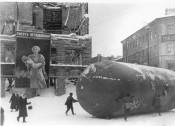
Relatively unknown pages of the first stage of the Battle for Leningrad in the Presidential Library stock
10 July 2017 marks 76 years since the beginning of the Battle for Leningrad — one of the most violent and longstanding battles of the Great Patriotic War. The evidences from the Presidential Library stock, which are included in the large-scale electronic collection entitled “Memory of the Great Victory,” tell about the courageous opposition of the Soviet army to the German invaders.
The battle for Leningrad consisted of defensive and offensive operations carried out by Soviet troops from July 10, 1941, to August 9, 1944. The bloody and tough nature of this confrontation was determined by the fact that the military-political leadership of fascist Germany appointed a specific meaning to the seizure of Leningrad. One of three strategic groupings of the Wehrmacht has to take the city — Army Group North, leaded by a representative of the old guard of career officers, 65-year-old Field Marshal Wilhelm von Leib: there was 29 selected divisions armed with the newest weapons behind him.
In a 2004 study by G. Shigin “The Battle for Leningrad: major operations, white spots, losses,” an electronic copy of which is available in the Presidential Library fund, we can read: “Hitler attached such strategic importance to Leningrad because that was a major political and the industrial center. According to a value of the gross output of industrial products in 1940 it was in second in the country place after Moscow and the flagship of shipbuilding. 30 percent of military production was concentrated in Leningrad. By taking Leningrad the Germans would also seize the Baltic Fleet, which prevented the most important shipments of Germany from the Scandinavian countries, primarily iron ore from Sweden.”
Hitler wrote in his diary: “To level Moscow and Leningrad to the ground in order to completely get rid of the population of these cities, which otherwise we (Germany) will later be forced to feed during the winter. The task of destroying the cities must be carried out by aviation. The tanks should not serve for this. It would be, according to Hitler, “a national disaster that will deprive the centers, besides of Bolshevism, also of Russians in general.” This is a quote from a book by I. Barbashin “The Battle for Leningrad, 1941-1944” published in 1964, which was digitized by the Presidential Library.
By the beginning of the battle, Army Group North of the enemy numbered 42 divisions, including 7 tank divisions. There were about 725 thousand people and 1500 tanks in it. In addition, Finland, which at the northern approaches to Leningrad concentrated its two field armies — the Karelian and the Southeast, participated in the war against the USSR on the side of Germany. By July 10, the troops of Army Group North, which were preparing an offensive against Leningrad, were numerically superior to the forces of the North-Western Front: 2,4 times in infantry, 4 times in guns, 5,8 times in mortars, 1,2 times in tanks. 1st Air Fleet, numbering 1070 aircrafts has to support the advance of Army Group North, while the North-Western Front had only 102 serviceable aircrafts, such information is from the above-mentioned book by I. Barbashin.
Military historiographers conditionally subdivide the battle for Leningrad into four stages: the fights on the outskirts of the city, an active defense in the conditions of the fascist blockade, the breakthrough of the blockade and the final frustration of the opponents. The first stage was for our army and city residents the most bitter and painful trial, because we were retreating and only at the end of this period have managed to repulse the invaders and take strong defensive positions, which later became the mainstay for deploying the victorious offensive of the Soviet troops.
So, on July 10, the German fascist troops resumed their offensive on the entire front from Pskov to Idritsa. The fighting on the approaches to Leningrad began almost simultaneously on the Luga, Novgorod and Starorussk, Petrozavodsk and Olonets directions, as well as in Estonia. It was difficult, but the 11th and 177th Infantry Division of the North-Western Front has managed to provide organized resistance to enemy tanks and infantry attacks. All attempts of the Germans to immediately break through the defense at the turn of the river Plussa failed. The battles have taken a long-drawn-out character.
Since July 13, fighting unfolded on the outskirts of Luga. The enemy, who suffered heavy losses, was forced to proceed to defense. Our artillery, in particular, the special artillery unit of the Luga Task Force, played an important role in frustrating the plans of the invaders to break through Luga to Leningrad. The enemy's plans were foiled.
In an electronic copy of V. Zubakov's book of 1960 “The Neva Stronghold” is told about the heroic resistance of the Northern capital, which was surrounded with the ring of the blockade: “A powerful ring of defense was created around the city. The total length of trenches, ditches, communications routes, shelters for infantry reached thousands of kilometers… Successfully passed the formation of the people's militia. Thousands of Leningrad citizens voluntarily joined the ranks of city defenders. The old Putilov worker, a participant in the defense of Petrograd in 1919, Peter Alekseyevich Soloviyev came to a military enlistment office and told: “My son 5 years ago voluntary joined Red Navy. I can’t stay at home during in such times…”
Despite the preponderance of forces and the optimistic forecasts of Wehrmacht analysts at the first stage of the Battle for Leningrad, the Germans were stopped. There were 900 days of blockade ahead. But the city-warrior staid in it, and the victory as a result was ours. About the incredible price, which it was earned, could be read in the materials of the collection of the Presidential Library entitled “Memory of the Great Victory.”

